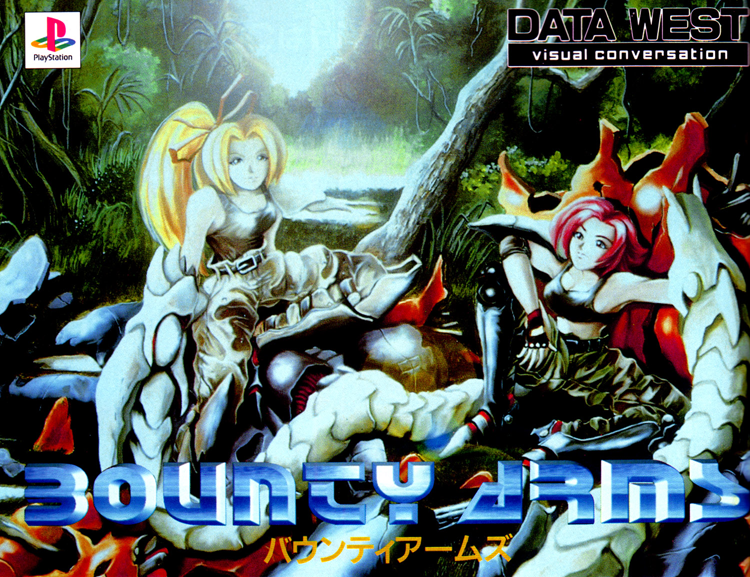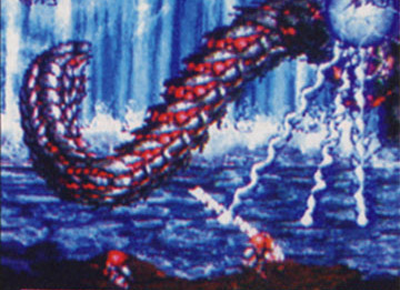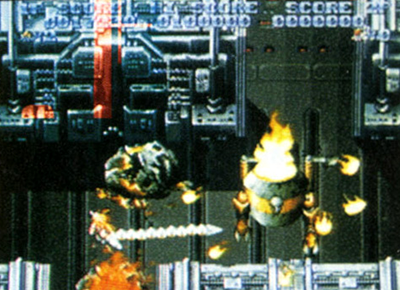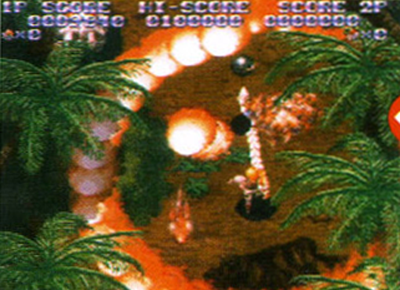Bounty Arms fascinates me. Unreleased games are tantalizing puzzles that often exist only in screenshots and half-complete prototypes, but there's something especially interesting about the unrealized potential in Bounty Arms. Both unique and appealingly traditional, it died with less than a whimper, denied any real attention even in its native Japan.
Data West was never a heavy hitter in the gaming industry. Primarily a software company that dabbled in games, they put together a catalog with only a handful of fully realized titles, the 1998 action-RPG Brave Prove and the early ‘90s shooter series Rayxanber being modest standouts. In 1995, Data West announced a little game called Bounty Arms for the PlayStation. At a glance, it resembles an overhead shooter in the vein of Commando, Ikari Warriors, or Mercs. Such comparisons were made when GameFan ran four screenshots of Bounty Arms in its April 1995 issue.
Yet Bounty Arms isn't a shooter. Previews in Japanese magazines revealed something a shade more inventive: an overhead action game where the characters wear and swing around telescoping mechanical arms. Known as Relic Arms, these weapons serve as grappling hooks, flamethrowers, and general-purpose whips. Their wielders are Rei Misazaki and her partner Chris, whose last name I can't render into any pronounceable English word.

|
The above magazine ad for Bounty Arms introduces our heroines, their unorthodox weapons, and their somewhat vacant stares. The blonde woman with the ponytail is Chris, and the redhead is Rei. Their busty, cute-nosed, anime-vixen look recalls the Genesis blaster Trouble Shooter (or Kei and Yuri of The Dirty Pair, to go straight to the source), but there's a unique touch to putting female leads in a genre that normally prefers bland, shirtless male soldiers. If you're going to build a better Guerrilla War, you can at least start with the dichotomy of underdressed women combatants, empowered and pandering all at once. It's not clear if Bounty Arms had a semblance of plot or anything else that might give its heroines personalities, but Chris' lack of a bare midriff might suggest her as the more reserved of the two. One can almost imagine cutscenes of her spouting cautious, fretful observations while Rei flirts with level bosses. That sort of thing passed as writing in games back in 1995.

|

|
As shown in various previews, Bounty Arms spans a variety of backdrops, from jungles to lakes to high-tech factories. These scenes are populated by mechanized soldiers, tanks, cannon turrets, swarming robotic drones, and the occasional cyborg creature. Perhaps the most striking one shown is the huge, jointed snake-beast that almost certainly serves as a level-ending boss. The surroundings don't look particularly vivid for a hand-drawn PlayStation game, though Bounty Arms strays a little from its genre's well-worn path. Numerous run-and-gun titles favored modern tones with jungle scenery (to the extent that one fan nicknamed the genre “South American Commando Slaughters”), yet Bounty Arms throws a high-tech theme into the mix, putting itself closer to Toaplan's Outzone than the likes of Ikari Warriors. There's also some fair detail in the sprites, and Bounty Arms seems to cram a lot of them on the screen at once.
Bounty Arms also reveals the Relic Arms to be surprisingly versatile weapons. The standard attack is apparently a whip-crack strike, but the extending cyber-arms can snatch up items, deflect bullets, and reach across gaps like some Bionic Commando device. Holding down the attack button apparently builds up a power meter and unleashes a massive whirl of flame from the Relic Arm, which broadens its reach with each power-up grabbed by Chris and/or Rei.
Much of Bounty Arms remains a mystery. The game's length and possible plotline are unknown, as are the finer points of its play mechanics. Magazines previewed the game in the early months of 1995, but Bounty Arms disappeared from sight shortly before its April release date. A later issue of GameFan, the only North American magazine to notice Bounty Arms, remarked that the game had been “canceled, I suppose.” However, Japanese PlayStation mags faithfully kept Bounty Arms in the “TBA” sections of their release lists well into 1998.
There remains the question of why Data West canceled Bounty Arms. In 1995, it had little direct competition, with no 2-D action games of its kind on the PlayStation, and few anywhere else. It may be that the company was intimidated by high-profile releases such as Ridge Racer, Toshinden, and Jumping Flash, or perhaps even lower-key 2-D titles such as The Raiden Project, Arc the Lad, and Gunners Heaven. The game industry was a very busy place in 1995, with Sony's introduction of the PlayStation, the Saturn's debut, the anticipation surrounding the Nintendo 64, and the unexpected viability of the last great 16-bit games. In such a climate, a company might shelve a project just because of all the other software flooding the Japanese market. It's a wonder anyone even noticed that Bounty Arms went missing.

|

|
Perhaps Bounty Arms, like many other canceled games, was scrapped simply because it's terrible. Still, there's a good idea in the traces it left behind. Many 2-D games imitate the vertically scrolling Commando shooter, and a tragically smaller number use Bionic Commando's idea of a multifunctional grappling arm. Bounty Arms steals from both sources, and the resulting gameplay would've been something genuinely new. Even today, the game industry hasn't seen anything quite like Bounty Arms.
It's a mere footnote in early PlayStation history, yet in only a few magazine previews, Bounty Arms makes me regret its loss. It's the sort of creation that deserves to be brought to light, flatteringly or not, and I welcome even the most trivial detail about the game or the company that created it. Bounty Arms may be lost, but I hope its story isn't.
UPDATE: A playable Bounty Arms demo can be found on a volume of Sony's Demo Demo PlayStation series. See this entry for details.
Further Information:
Screens and text from “Nick Rox's PlayStation Previews,” GameFan, April 1995
Preview from PlayStation Magazine, March 1995
Preview from PlayStation Magazine, April 1995
Preview from PlayStation, April 1995
An ad from PlayStation, April 1995
Preview from the “1995 Spring” PlayStation Guide
Lost Levels: Bounty Arms and Bare Midriffs